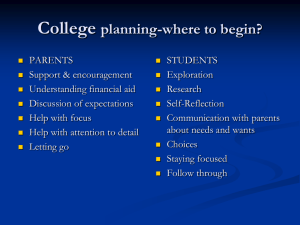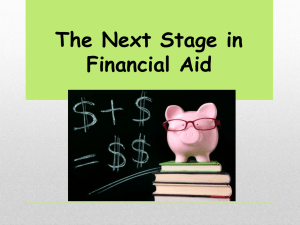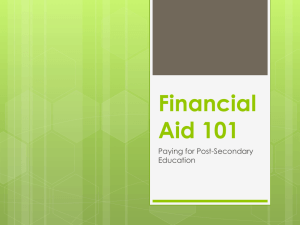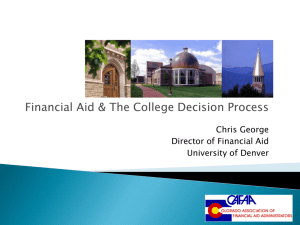Parent Presentation
advertisement
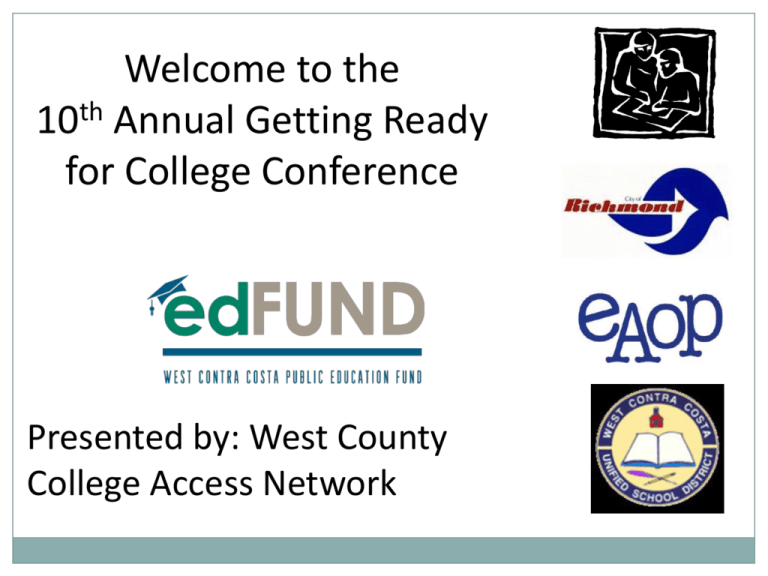
Welcome to the 10th Annual Getting Ready for College Conference Presented by: West County College Access Network “Education is the most powerful weapon which you can use to change the world.” Nelson Mandela Agenda Welcome Goals/Objectives Why College? College Admission College Preparation Higher Learning Institutions College Application Student Personal Statement Parent/Guardian Checklist Paying for College Closing Why College? High school diploma is no longer enough Enables student to earn higher income and provides chance to work in better conditions Enhances skills, knowledge and abilities (SKA) Offers opportunity for personal development and future accomplishments Creates positive role model for community Provides quality life experiences – EXPOSURE Why Invest in College? College Admissions College Prep over 4 Years 9th Grade 10th Grade 11th Grade 12th Grade • Plan Out 4 Year Class Schedule • Grades Matter! • Take on Academic Challenges • Apply to Colleges Early • Explore Extracurricular Involvement • Continue Involvement • Pursue Leadership Opportunities • Meet Provisions of Admission • Take PSAT Exam • File FAFSA or California Dream ACT Application • Maintain GPA • Explore Interest/College Majors • Prepare for PSAT • Explore College Majors/ Campuses • Practice for SAT and ACT • Tour College Campuses • Apply for Scholarships • Continue to EXCEL! College! 10th and 11th Grade •Ensure on track to complete A-G requirements •Enroll in Advance Placement (AP) or College Courses •Download SAT practice booklet – www.collegeboard.com •Download ACT practice booklet – www.act.org •Register for College Admission Exams – Check for fee waiver •Pursue Leadership/Community Service/Volunteer Opportunities •Visit School Counselor to learn about College Access Programs available on campus •Tour Colleges – Visit colleges websites regarding tour dates •Create Scholarship Search Accounts – www.fastweb.com •Research and Apply for scholarships – e.g. Nordstrom offers $10K for high school juniors 12th Grade •Visit school counselor to identify College Access Programs available on high school campus •Prepare a personal statement and resume •Create a college binder/activity calendar/carry a flash drive •Visit colleges websites to review specific admission requirements and information for potential/future students •Obtain 2-3 letters of recommendations – Ask teachers, counselors, community leaders, and/or extracurricular activities/club leaders •Obtain high school transcript and create list of extracurricular activities, community or volunteer services, and/or awards •Apply to colleges EARLY and check email account regularly 12th Grade Continued • Create Scholarship Matching Accounts - www.fastweb.com www.scholarshipexperts.com, www.studentscholarship.org • Apply for Scholarships – local, state, national, civic, social, check high school website, future attending college website, etc. • Submit a Free Application for Federal Student Aid (FAFSA) – www.fafsa.ed.gov or a California Dream ACT Application www.caldreamact.org • Create a Web4Grants (WGS) account–www.webgrants4students.org or https://mygrantinfo.csac.ca.gov/ • Create a CSU Mentor account if applying or interested in learning more about California State Universities (CSU) – www.csumentor.edu • Continue to EXCEL! Types of Institutions • Community College (2 years) •Associate’s Degree University (4 years) •Bachelor’s Degree Proprietary Schools (6 months – 4 years) •Certificate •Associate’s •Bachelor’s •Masters High School Diploma/GED Graduate or Professional School (2-6 years) •Masters •Doctorate College: Choosing the Best Fit Factors to Consider: • Areas of Interest/Majors • Cost of Attendance (COA) • Attend a CSU, UC, Public, or Private Institution • College Term – Quarter (8-10 weeks) Semester (16-18 weeks) Geographical Location • (in-state, out-of-state or international student determines resident fees) • Campus Life/Size Impacted Majors and Campuses Impacted Undergraduate Majors and Campuses in the California State University (CSU) 2016-2017 An undergraduate major or campus is designated as impacted when the number of applications received from fully qualified applicants during the initial filing period exceeds the number of available spaces. CSUs Fullerton, Long Beach, San Diego, San Jose, and San Luis Obispo campuses are impacted in all majors. College Applications College Applications may require: • • • • • Official High School Transcript Personal Statement Letters of Recommendation Standardized Test Scores – SAT and/or ACT Financial Aid Application (FAFSA/CA Dream Act Application/SAR) College Applications Fee CSU campus admission application requires a $55 fee (per application) UC campus admission application requires a $70 fee (per application) Fees are nonrefundable, may not be transferred to another term, and are subject to change. College Fee Waivers Application Fee Waivers Community College: Board of Governors (BOG) Fee Waiver CSU campus: California residents who demonstrate financial need may qualify for an application fee waiver. Students are allowed to submit application fee waivers to up to four CSU campuses when they apply using the CSUMentor site. UC campus: Will waive application fees for up to four UC campuses for qualified students who would otherwise be unable to apply for admission. The fee waiver program is for United States citizens, permanent residents, and applicants eligible for AB540 benefits. College Applications Quick Glossary Free Application Federal Student Aid (FAFSA) Student Aid Report (SAR) – Summary of information completed on FAFSA Expected Family Contribution – (EFC) Four (4) easy steps to access college glossary: 1) Visit https://fafsa.ed.gov 2) Click on About Us tab (located upper left corner) 3) Scroll down to More Infor (located lower right corner) 4) Click on Glossary Personal Statement Student’s Personal Story • Opportunity to supplement application • Describe challenging circumstances and/or barriers overcome Write about interests, talents, personal experiences, 1st generation to attend college, childhood, future academic and career goals, and why student wants to attend college • Personal Statement (cont.) Allocate Sufficient Time To: • Drafting personal statement • Reviewing personal statement • Revising personal statement based on feedback from two (2) reviewers • Finalizing personal statement for submission with college applications and/or scholarships opportunities Parent/Guardian Checklist First 5 Create a College Planning/Event Calendar with highlight deadlines Establish deadlines for College Preparation Activities – e.g. personal statement, college applications, create WebGrants for Student Account, scholarships etc. Obtain high school transcript/awards/club activities Visit various colleges websites to ensure clear understanding of college admission requirements Establish relationship with high school College Access Program contact or “Google” College Checklist Parent/Guardian Checklist (cont.) Next 5 Ensure student is on track with A-G requirements and passed Exit Exam Visit various colleges websites and review information for potential/future students Plan college tours – Visit selected colleges websites for tour dates, discuss living arrangements, review Cost of Attendance Network with family, friends, co-workers, and check social/civic organizations regarding scholarship opportunities Check employer’s website for scholarship opportunities Important Deadlines • California State University (CSU) Applications: Fall 2015 filing period - October 1 – November 30, 2015 WCCUSD PSAT (Juniors) and SAT (Seniors) scheduled during school/home school - October 14, 2015 • University of California (UC ) Application Fall 2015 filing period - November 1-30, 2015 • • Submit FAFSA (www.fafsa.ed.gov) or CA Dream Act Application (www.caldreamact.org) Check with school regarding “Cash for College Night Workshop” - January 1 – March 2, 2016 Note: Review Student Aid Report (SAR) and submit corrections as soon as possible College Admission Notifications – ( UC post admission online) - March 1-30, 2016 • Submit Statement of Intent to Register (SIR) by - May 1, 2016 • Submit Official high school and college records by - July 1, 2016 • FINANCIAL AID What You’ll Learn Today •Different forms of money for college •How to get it •Where •When to get it to get it What are the costs? Tuition & Fees Room & Board Transportation Books & Supplies + Miscellaneous Living Expenses Cost of Attendance (COA) Grants ScholarshipsWork-Study- LOANS- Sources of Financial Aid Federal Government College (institutional aid) State Government outside/ private Sources GRANTS Federal Aid •Federal Pell Grant: need-based, up to $5,775 •Federal Supplemental Educational Opportunity Grant: exceptional need, up to $4,000 State of California Aid •Cal Grants -Must be a CA resident or AB540 attending an eligible institution in CA -Must make satisfactory academic progress as determined by the institution Work Study A need-based employment program that provides on- and off-campus jobs to students. The amount of work study is determined by FAFSA Compensation is at least the current federal minimum wage A student must work for these funds Subsidized vs. Unsubsidized To understand the difference between the two, consider this: When will interest begin to accrue? Type Need or No Need Interest Subsidized Stafford Loan A need-based loan Interest is paid by the federal government while a student is in school at least ½ time, during grace period, and during authorized periods of deferment Unsubsidized Stafford Loan NOT a needbased loan A student is always responsible for paying interest WHO IS ELIGIBLE FOR WHAT? US Citizen or Eligible NonCitizen Undocumented/ AB540 Students (Fill out Dream Application) Foster Youth Federal Financial Aid (Pell Grant + State Aid + Institutional Aid+ Scholarships) State Financial Aid (State Aid + Institutional Aid+ Scholarships) All Financial Aid (Pell Grant+ Chaffee Grant+ State Aid + Institutional Aid+ Scholarships) Applying for Financial Aid FAFSA4caster • Get a head start on the FAFSA application! • Check out your financial aid eligibility before 12th grade at: http://www.fafsa4caster.ed.gov Financial Aid for Undocumented Students-AB131 AB131: Authorizes AB540 students to apply for state aid: Board of Governor’s Fee Waiver Cal Grants Effective January 1, 2013 Financial Aid for Undocumented Students-AB130 AB130: Authorizes AB540 students to apply for privately funded scholarships given out by a CA public college/university. Effective January 1, 2012 Requirements: -Be classified as AB540 -Scholarships’ requirements will be implemented by each campus. Financial Aid for Undocumented Students • • • • • Not eligible for FAFSA Eligible for CA Dream Act AB130 Private Universities Private Scholarships – www.E4FC.org How can parents help? Ensure students: – Are aware of types and sources of financial aid – Get help from their school to fill out the FAFSA – Submit the FAFSA/CA Dream Application as early as possible (if eligible) – Do your Taxes early!! – Check the SAR for accuracy – Meet state deadlines for financial aid (3/2/16) – Communicate with their institution’s office of financial aid New in 2016…. FSA ID Federal Student ID (replaces PIN) An FSA ID is a username and password that you must use to log in to certain U.S. Department of Education (ED) websites. Your FSA ID identifies you as someone who has the right to access your own personal information on ED websites such as the Free Application for Federal Student Aid (FAFSA®) at fafsa.gov. www.fsaid.ed.gov •Usually ONLY IF PRIVATE SCHOOL REQUESTS THIS FORM •PROFILE Application deadline is February 1, please be aware that on January 29, 30, 31, and February 1 activity on the PROFILE website is heavy. •The fee for the initial application and one college or program report is $25. Additional reports are $16. •A limited number (6 total) of fee waivers are granted automatically — based on the information entered on the PROFILE application — to students who are first-time college applicants and are from families with low incomes and assets. The Financial Aid Process Complete FAFSA/DREAM APP Receive and review the Student Aid Report Complete verification process Receive and review Respond Complete all pending processes Award Offer Renew FAFSA/ DREAM APP every year to college (if selected) Applying for Scholarships What is a Scholarship? Money awarded (free) to students based on academic or other achievements to help pay for education expenses. Award Based on: Financial need Merit Special Talents Experiences, etc. NEVER pay to access scholarship information! Scholarship Resources Scholarships Fastweb: Fastweb.com Scholarships from all over the country. East Bay Consortium Scholarship Directory: eastbayconsortium.org A variety of local and national scholarships. Ed Fund: Edfundwest.org For low-income WCCUSD seniors with a 2.5 GPA and above. Educators for Fair Consideration (E4FC): e4fc.org Supporting undocumented students The Gates Millennium Scholars: www.gmsp.org QUESTIONS? THANK YOU! kglosson@peralta.edu Closing Attend Resource Fair Complete College Conference Evaluation for entry into Conference Raffle Closing Thought If you can dream it, you can do it. Walt Disney Richmond Promise 47 48
